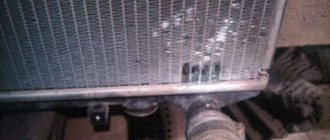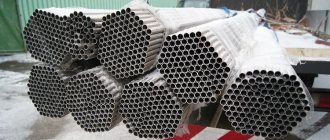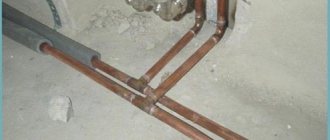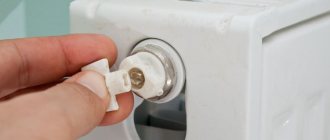A siphon is leaking in the bathroom: ways to eliminate the leak
1. If the ring has burst or stretched, then replace it with a new one.
2. If the overflow pipe bursts, replace it by installing a new one. You can also read about how to remove the siphon from the bathtub and replace its parts with new ones in the article on our website “Installing and replacing a bathtub siphon.”
3. If the ring has moved, then correct it and tighten the nut well.
4. If the siphon is dirty, do the following:
5. If the O-rings have changed shape, this may be due to cleaning the siphon. And you will not be able to return the siphon to its place as it was long before its current form. Therefore, it is better to change the siphon when cleaning it.
Perhaps the siphon under your bathtub is leaking because you chose it incorrectly? The article on our website “Types of bath siphons” will tell you about the different types and models of these devices
Let the instructions on our website on how to choose a bath siphon become your guide to the world of plumbing. Read it here: https://remontspravka.com/siphon-selection/
How to install or replace a siphon with your own hands? Refer to the advice of experienced people on our website!
Often replacing the rings does not help. Then - seal the joint between the siphon and the bottom cover with silicone sealant.
6. If the siphon is leaking under the bathtub at the junction of the drain and overflow pipes, then seal the entire circumference of the joint over cement sealing using liquid glass, i.e. office silicate glue. This way, you will reliably seal the cracks in the cement.
7. If the siphon connections are not tight, apply sealant to them. Also, additionally “wind up” the thread with tow or special silicone tape if it does not fit tightly. And then coat the thread with paste and screw the part.
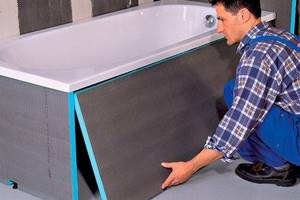
Siphon repair completed
Source
How to fix a leak under a bathtub
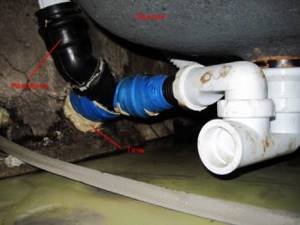
It often happens that after taking water procedures in the bathroom, a puddle forms on the floor. Of course, the most economical option is to hang a curtain. But if it doesn’t help, and puddles still form on the floor, it means that water is seeping through the cracks between the bathtub and the wall, it’s time to think about how to somehow seal this gap.
Problem resolution options
Experts know many ways to deal with this problem if water is leaking. Before choosing how to eliminate leaks between the bathtub and the wall, it is worth familiarizing yourself with all the methods in detail.
Gap between bathtub and wall
Usually one of the following methods is used:
- seal the gap with mortar;
- foam the joint with polyurethane foam;
- filling the gap with silicone sealant;
- curb tape is installed.
A plinth made of ceramic or plastic is installed along the edges of the bathtub and between the wall. According to Soviet standards, a bathroom was included in the design of a house or apartment based on the standard dimensions of the bathtub itself. If the size of Soviet baths is 170 cm, then a typical bathroom was also 171 - 172 cm wide.
Currently, the approach to the design and construction of apartment buildings has changed. The dimensions of the bathroom spaces have also changed. In addition, the range of bathtub models has expanded significantly, which differ from the standard ones in both configuration and size. Naturally, when purchasing a non-standard bathtub, a gap appears between the bathtub and the wall.
Small cracks and methods for sealing them will be discussed below, but what should you do if there is a gap of 4 cm or more? In this case, you cannot do without installing a protective screen. Underneath it is necessary to install a frame made of wooden blocks, boards or a metal profile. This design is sheathed to choose from:
- waterproof GVL;
- plywood;
- fiberboard sheets.
Alternatively, you can glue ceramic tiles on top of this base (use “liquid nails”). Fill the gaps between the tiles with a special grout, and fill the junction with the bathtub with a waterproof sealant. For small gaps between the wall and the bathtub, there are other ways to eliminate leaks.
Solution
The easiest way to fix a leak is to fill the joint with cement mortar.
The procedure is as follows:
- the joint surfaces are cleaned of dirt and dust;
- to prevent the mortar from falling through, the gap is filled with rags soaked in cement mortar;
- apply a solution of medium thickness to a pre-moistened surface;
- a tile border is laid on top;
- if the bathroom walls are simply painted, the joint can be painted with the same paint.
Where to start fixing a leak
Standard situation - it was discovered that a pipe is leaking: what to do in such cases? The first step is to determine exactly where the pipe is leaking. If a sink, washbasin or bathtub drain is leaking, the cause of this phenomenon is usually a poor-quality connection of the drain hole, siphon and entrance to the pipe.
In this case, to fix the problem, you will need to tighten all the threaded connections through which the sewer pipe flows. Sometimes it helps to replace the gaskets at these joints.
External sewerage repair
It often happens that a sewer problem is not limited to your home, but affects the entire system. In such cases, in order to identify the cause and location of the breakdown, repairs must be carried out along the entire length of the sewer pipe leading from your home.
At first glance, this may seem too complicated and time-consuming, however, if you entrust the work to the craftsmen, it is possible to repair sewer pipes without opening them, which will take the employees no more than one working day.
Experienced craftsmen will clean the old pipe from corrosion and traces of breakage, after which they will pass a new (polyethylene) pipe into it, which, of course, will lead to a decrease in the overall diameter of the sewer, but will increase its strength and throughput several times.
Polyethylene pipes in connection with old cast iron pipes have a number of advantages, such as durability, high strength and small diameter and weight. Such repair of sewer pipes, using the pipe-to-pipe method, will significantly save your money, time and personal comfort, allowing you not to replace the sewer along the entire length of the system.
If a pipe leaks at the connection
Using the caulking method for cast iron pipelines
If leaks are detected at the junction of cast-iron sewer pipes, you should prepare for a rather complex procedure for eliminating the problem (read: “How to repair a crack in a cast-iron sewer pipe - reliable and proven methods”). In this case, much depends on the quality of the docking work.
If caulking is carried out with lead, the procedure is as follows:
What to do if the pipe in the toilet is leaking:
Installing the bandage
If a pipe in the bathroom is leaking, a temporary solution to the problem is to install a bandage. Before this, you need to determine what type of damage you will have to deal with (fistula or leakage), and where exactly it is located.
The rubber band is applied as follows:
You can easily purchase a clamp in a store, but it happens that you don’t have it at hand at the right time. In this case, you can make the clamp yourself, or use wire, a harness, rope or hose instead.
The bandage rubber can be an old rubber boot, from which the boot is cut off. The same goes for a rubber hose and a bicycle tube. The width of the bandage is made depending on the diameter of the pipe being repaired.
Using a wooden wedge in the bathroom
There are situations when a high-pressure leak occurs, but there is no possibility of shutting off the water: how can you prevent the pipe from leaking? A bandage usually doesn’t help in such a situation either.
If the leak is caused by a fistula, it can be eliminated using a small wooden peg in the form of a wedge. The size of its tip is made the same as the resulting hole in the pipeline.
The peg with its sharp end is inserted into the fistula, after which it is hammered in with a hammer. This temporary measure allows you to gain time needed to call emergency services.
Sealing a pipe in a toilet
A leak in a pipe can also be eliminated with an adhesive bandage.
The procedure in this case is as follows:
When using fiberglass, the cut piece should be enough to wrap the pipe at least 5-6 times. The width of the bandage should exceed the diameter of the pipe by at least one and a half times. It is more convenient to apply glue to the bandage with a brush or spatula.
After wrapping the bandage fabric around the pipeline, it is secured with a tie or clamp until it dries completely. The glue usually dries within 24-72 hours. The air temperature must be at least + 15 degrees.
If a metal pipe is leaking
It often happens that a pipe in the bathroom leaks: what should you do to avoid flooding the apartment and the neighbors below?
In this case, proceed as follows:
Before screwing on the coupling, it is necessary to seal the threaded sections of the section using flax, sealing putty, or a special tape-fuser. In addition to repairing metal pipelines, leaks on pipes made of other materials can be repaired in the same way. If it is not clear what to do if a pipe is leaking, it is best to turn to professional plumbers for help.
Source
Repairing leaks at pipe joints using cement
What to do if a pipe is leaking, and the only possible materials available are cement?
In such a situation, work is carried out as follows:
- The pipe junction area is cleaned, with the obligatory removal of the old seal. To avoid damaging the pipes, it is better to refrain from using heavy tools.
- Next, you need to get a wide gauze bandage. Cement is mixed with water to form a slurry. A bandage is immersed in the resulting solution.
- The same cement mortar is used to treat the joint between the pipes, and then wrap a bandage there.
- The hardening of the seal usually lasts for two hours, after which it can be sanded and painted.
In cases where a leak was detected directly on the pipe body, a completely different algorithm of actions will be required.
Features of diagnosing a faulty siphon
Most often, the cause of the leak is determined after disassembly. By the way, it is highly desirable to disassemble and assemble the siphon without the use of special tools. After disassembly, each part must be inspected and, if necessary, cleaned of dirt. It is better not to use wrenches when assembling and disassembling the siphon, even if we are talking about a metal element, and even more so if it is a plastic one. The plastic is quite fragile and a wrench can damage it.
Before disassembling a faulty siphon, it is recommended to take the following measures. Buy a special product for cleaning drain pipes and pour the mixture into the drain, then rinse with boiling water after a while. This will slightly clear the siphon of contaminants and simplify the disassembly process in the future.
After determining the location where the malfunction occurred, the water supply is shut off and the siphon can be removed. It is better to disassemble the plastic version exclusively by hand, but when disassembling the metal version, you can use power tools. In a metal siphon, the nuts can stick tightly to the metal, so it is better to cut off their caps with a grinder so as not to damage the structure, and simply drill out the remaining fragments. When the drain is disassembled, it is advisable to wash each part in hot water and soap. No foreign chemicals should be used as there is a risk of damaging the equipment. The cleaned parts are wiped and dried, and then repairs can begin.
Smells
Where does the unpleasant smell in the bathroom come from?
As you might guess, its source is the sewerage system. In normal mode, the sewer riser is ventilated through a fan outlet onto the roof, and all odors are drawn out to the street. However, in some cases the ventilation may stop working.
Here are a couple of typical scenarios that lead to odors:
- In winter, snow freezes on the inner surface of the drain pipe . Gradually, it narrows the gap to zero, and the draft arising in the riser begins to transport aromas to the apartments of the upper floors;
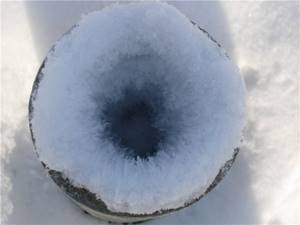
Frost on the fan pipe.
- Residents of the top floor, during the next renovation, often dismantle the unnecessary, from their point of view, thick and ugly pipe above the tee behind the toilet.
How can you solve the problem?
If the smell of sewerage appears in winter, at the peak of cold weather, just go out onto the roof above your apartment and pour a bucket of hot water into the frozen riser. To prevent it from freezing again, wrap the pipe with any moisture-resistant insulation (for example, polyethylene foam).

The penofol shell will prevent the pipe from freezing.
If the riser has been dismantled by neighbors on the top floor, you can contact representatives of the housing department or service company. Unauthorized change in the configuration of public utilities is a gross violation of the administrative code. The culprit restores the riser at his own expense.
Finally, the most universal solution is to create a reliable barrier between the sewage system and the atmosphere in your apartment.
- All connections between plumbing fixtures and sewer pipes are reliably sealed . To do this, use sealing cuffs sold in plumbing stores or any available material - even tape and plastic bags;
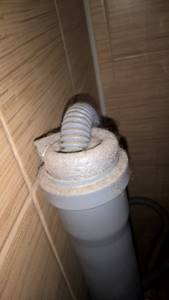
I used leftover pipe insulation to seal the washing machine drain.
- Siphons with a maximum height of the water seal are installed on the bathtub and washbasin , preventing it from breaking.
Methods for eliminating leaks
As a rule, repairing a siphon is not a difficult task. And the materials necessary for this can be found in the pantry of almost any home. Below are some recommendations on what to do if the siphon is leaking.
Required Tools
Plastic siphons can be disassembled by hand, so no special tools are needed. Although in some cases a screwdriver, a cable for cleaning drain pipes may still be useful (a metal brush with a long handle or even an ordinary wire brush will also work), and it is advisable to stock up on a rag and a container for water. To restore the tightness of spare parts and their joints, silicone glue or sealant, a “liquid nails” type composition, and sometimes even a regular medical bandage are useful.
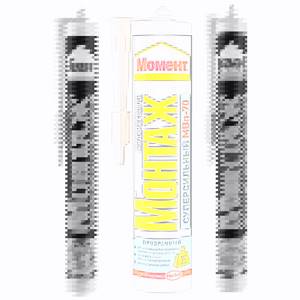
Siphon leaks can be eliminated using “liquid nails”
If you have to disassemble a metal siphon, especially one that has been in use for a long time, you may need tools such as a grinder and a drill. With their power, it will be possible to disassemble the siphon by sawing off the caps of the bolts, and then drilling out what is left. In order not to damage the metal siphon during disassembly, it is recommended to use power tools.
Restoring the tightness of gaskets
Abrasion or other changes in the condition of the gaskets can cause the siphon to begin to leak. Rubber parts that have hardened during use are best replaced. Usually they are available in any specialty store. In order for the purchased parts to last longer, they are lubricated with liquid soap or Vaseline, which facilitates the installation process.
However, there is not always the desire or opportunity to purchase new gaskets. In this case, you can try to restore the old ones. To restore them, they must be lubricated with silicone glue, sealant, or a compound called liquid nails, and then put in place. When the applied composition dries, the plumbing fixtures can be used. This measure will extend the life of the rubber gaskets for several more years.
Repairing cracks
If the pipe is cracked at the seam, then repairing it is quite simple. To begin with, the split site is cleaned with sandpaper and then lubricated with pre-diluted epoxy glue. If desired, dyes can be added to the composition used.

To repair cracks you will need epoxy glue
When the surface is lubricated, it is wrapped with a medical bandage. This event is performed two or three times. This creates several layers of epoxy glue and bandages on the pipe. The drying time for this design is about six hours. After drying, the siphon can be put back in place and the plumbing can be used. A pipe reinforced in this way becomes much stronger than the one originally purchased.
Sealing connections
Sealing of connections may be necessary due to manufacturing defects or during operation. Sometimes it becomes necessary to additionally seal the joints of the siphon parts. For example, a worn thread prevents the rubber gasket from being pressed tightly against the hole. In this case, tow or silicone tape is used for compaction. It is important to remove excess sealant after securing the nut. In some cases, if the thread is seriously damaged, cold welding can be used, however, this will extend the service life for only a short time, since the fragile plastic will soon continue to crumble. In this case, it is better to take care of purchasing a new siphon.
Chemical methods to combat leaks
Such repair of water pipes without welding involves the use of various chemical compounds.
Metal polymer "Emergency"
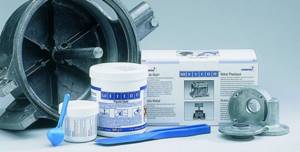
Another name for this product is epoxy composite. This is a professional putty mixture that allows you to quickly and reliably eliminate any small leak. It consists of metal dust, which is mixed with epoxy resin.
Various fillers are used: there are metal polymers with aluminum, bronze, steel, titanium. There are compositions with minerals - with carborundum or zircon. Before repair, the components are connected and quickly applied to the damaged area. The layer thickness is 10 mm. This putty hardens in 24 hours. Mechanical processing of dried metal polymer is permitted.
Silicone and paint mesh
Often sealants become saviors. More specifically, one type of them is silicone-based. Its advantages are increased wear resistance and the ability to withstand maximum temperatures (up to 350°) without problems. The second required element is a painting cloth made of fiberglass.

Repairing water pipes without welding consists of several stages.
- First, the damaged surface is cleaned, then a thin layer of sealant is applied to the area: no more than 2-3 mm.
- Then the painting cloth is wound around the pipe section, end to end. After this, a layer of sealant is applied again, and then the reinforcing material is screwed in, but with a larger overlap: the overlap on the turns is 5 mm.
The total recommended number of layers is at least 4. The fabric is wound as tightly as possible. The last layer is always sealant. The pipe section must dry, but the time required for such a dressing to dry depends on the type of sealant. Some compounds dry in a few hours, others take a day or more.
Superglue and soda: for any pipes

This successful "duet" is universal, as it can be used for plastic and metal water pipes. However, there are mandatory conditions: damage to the area should be minimal, the surface requires high-quality pre-treatment. First, the problem area is cleaned with a file (grinder), then dirt and dust are removed, and degreased with any solvent.
- The first layer of painting cloth is wrapped around the damaged area. A layer of baking soda is applied to it.
- Then this operation is repeated two more times, since 3 layers of fabric/soda are needed.
- The last stage is applying glue. For example, with a small spatula.
The instant composition instantly reacts with soda, forming the most durable film that water cannot destroy. If the damage is not a hole, but a crack, then proceed differently. Baking soda is poured into it, and glue is applied on top.
FUM, flax in case of an accident on the thread
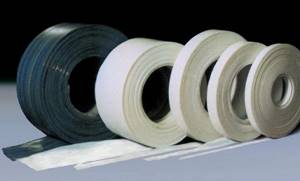
This type of repair of water pipes without welding is traditionally used in areas where pipes are joined. A leak that appears on a threaded connection is eliminated with FUM tape or linen thread impregnated with a waterproof compound. This operation is quite simple.
- Before work, the old sealing material is completely removed.
- The area is cleaned of rust and degreased.
- Wind the new tape tightly.
The number of turns is from 4 to 25. It is influenced by the size of the pipe, thickness, and width of the tape. The main task of winding is to hide all the threads. Unlike plumbing tape, less flax is needed, since this natural material does not shrink as much during use. After winding, it is recommended to moisten the tow with alcohol, then coat it with BF-2 glue.
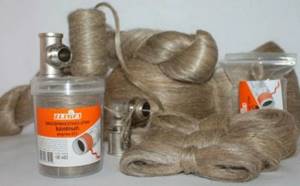
Since FUM tape is available in three types, you need to know which products you need to buy. FUM-1 is a lubricated tape: it is made on a Vaseline base (17-20% medical oil). These products are used for sealing water supply systems in any aggressive environment.
FUM-2 is produced without lubrication, so it can be used to seal those systems that operate on oxygen or other strong oxidizing agents (for example, gas). FUM-3 is a product made from the edge parts of the first two brands. Such tapes are able to withstand strong environments - both dilute solutions and concentrates of acids and alkalis.
Cold welding method

Strange as it may sound, water pipes can be repaired without welding using “cold welding”. This is an adhesive composition that received its “loud name” because of the reliability and strength of the connection. This material is used to seal fistulas in any pipes - hot water supply and cold water supply. Since there are several types of cold welding, you need to buy one that “specializes in wet work.”
The work should be done with gloves, but it does not cause any difficulties:
- All rust or paint is removed from the area with the hole at a distance of 30-40 mm, a small fistula is enlarged using a drill;
- the remaining particles and dust are removed from the “accident site”, then the prepared surface is degreased with a solvent;
- cold welding is applied to the area, distributed evenly, making a layer 2-3 mm thick.
Cold welding begins to set within the first 10-15 minutes, but it is better to wait: do not turn on the water for 2.5-3 hours. After the composition has hardened, the surface is slightly leveled with a file or sandpaper, cleaned and degreased again, then painted.
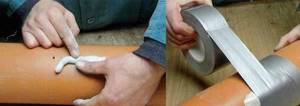
However, this "welding" method is designed to fix only the smallest holes. When the pipe is under pressure, it is first recommended to drive a plug of suitable size into the fistula, and then coat the area with cold welding. If the defect is large, then it is better to use an additional, more reliable option as soon as possible.
Prices for cold welding can be found here:
Recommendations for the operation and prevention of siphon leaks
The siphon, like many other household items, needs maintenance. It must be disassembled and cleaned at least once a year. At the same time as cleaning, it is recommended to check the parts for scuffs and other damage. Also at this moment it is worth changing the gaskets or lubricating the old ones with sealant.
It is important to remember that to prevent contamination of the siphon, you should not pour food waste, tea leaves, or even just dirty water into the sink, as the water will go away, and all other impurities will remain on the walls of the structure and, at best, will lead to the need for quick cleaning. Before you pour anything with foreign particles into the sink (everything except water, including even ordinary soup), you need to install a special strainer that will protect the siphon from waste. The stuck particles are removed from the strainer and thrown into the trash.
By the way, when pouring out a fatty liquid, it is worth considering that fat can also settle and accumulate on the walls of the siphon. This can be partly saved by special chemical mixtures for cleaning drain pipes. They, of course, will not replace a full cleaning procedure, but they will allow you to perform it a little less often. The main thing when using such household chemicals is to carefully read and follow the instructions on the packaging, otherwise the procedure may not have any effect.
Source

